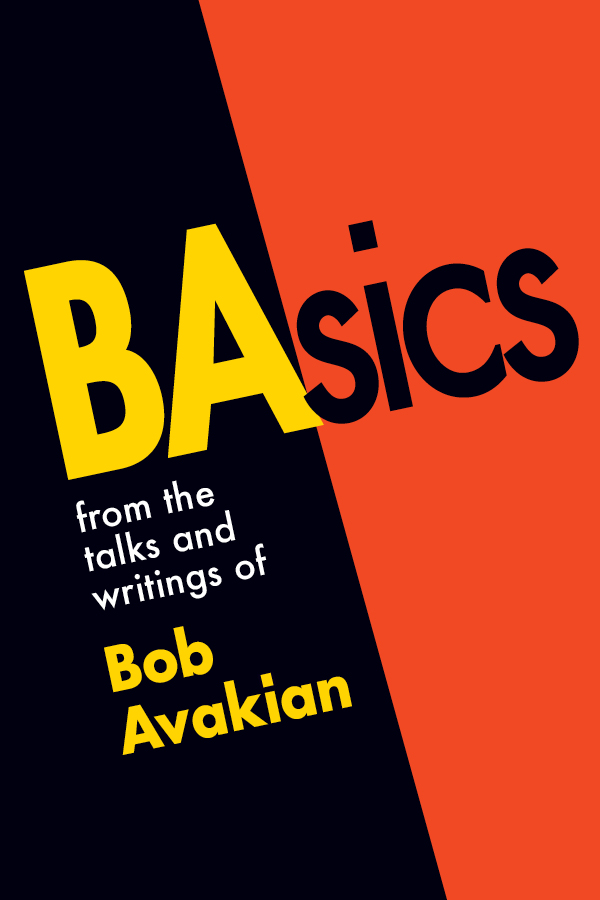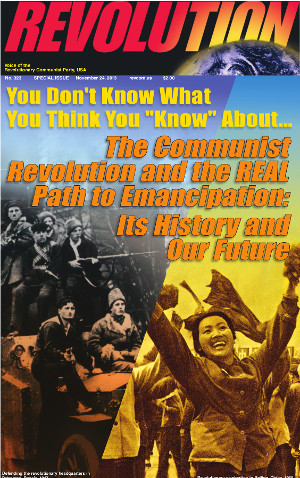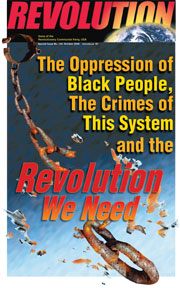Puerto Rico: Background to a Crisis
August 10, 2015 | Revolution Newspaper | revcom.us
Last month, the governor of Puerto Rico announced that the government's $72 billion debt was "not payable," and that the island's economy was in a "death spiral." Then, on August 3, the government defaulted on a bond payment of $58 million, the first default since Puerto Rico was brutally invaded and subjugated by U.S. troops in 1898 and made a colony, which it remains today.
Puerto Rico has been in a major recession the past eight years, largely the result of the recession on the U.S. mainland that began in 2007, but with even greater dire results. Some 45 percent of the island's 3.7 million people live under the poverty line, the unemployment rate is 12-14 percent, twice that of the U.S., and the people are staggering under government austerity measures, with large cuts in social services, a four percent increase in the sales tax, higher interest rates, dozens of school closings, and a proposed $166 million cut in the public university system, which led to large student demonstrations and fierce confrontations with the police in May.
Perhaps most serious is a looming health crisis, due mainly to large cuts in Medicare and a Medicaid program serving 1.6 million people that could run out of funds by the end of next year. Doctors are leaving the island at a rate of 400 a year, on an island that already has too few doctors to serve the people's health needs, and large numbers of the unemployed as well as others are also leaving Puerto Rico to come to the mainland in hopes of finding jobs and a better life.
U.S. law forbids Puerto Rico from seeking bankruptcy protection, and Congress is refusing to consider financial assistance, calling it an undeserved "bailout." The Obama administration and the U.S. Treasury have also ruled out financial assistance, demanding instead, along with multibillion-dollar U.S. hedge funds and other shark creditors, that Puerto Rico come up with a plan to avoid further defaults and pay the debt, which will require even more draconian austerity measures and a further deepening of the "death spiral."
The current economic and social crisis is breaking out in the context of oppression and resistance to 115 years of U.S. colonial rule. Below is an article that originally appeared on the 100th anniversary of the U.S. colonization of Puerto Rico in the Revolutionary Worker, the forerunner of Revolution/revcom.us. It provides basic background on the U.S. colonization of Puerto Rico.
Also, to the right, is the section from the Constitution for the New Socialist Republic in North America describing how, with the grip of U.S. imperialism finally broken, the new socialist society in North America, on the basis of internationalist principles, will recognize the Puerto Rican people's right to independence and their right as a nation to self-determination.
* * * * *
May 12, 1898: U.S. Opens Fire on Puerto Rico
Revolutionary Worker #956, May 10, 1998
One hundred years ago--on May 12, 1898--seven U.S. warships opened fire without warning on the town of San Juan on the northern coast of Puerto Rico. Two and a half months later, in July, U.S. troops landed in Puerto Rico for the first time and seized control of the island from Spain.
The United States came to Puerto Rico claiming to be liberators. But it quickly became clear that the old and weakened Spanish colonialists had been replaced by a new and more powerful oppressor. For the Puerto Rican people, the events of 1898 marked the beginning of military occupation, exploitation and poverty, cultural suppression and national subjugation under the bloody flag of U.S. imperialism.
From Stealing a Continent to Conquests Across the Seas
The military conquest of Puerto Rico was part of a major colony-grabbing thrust by the United States across the waters of the Caribbean and the Pacific.
At the end of the 1800s, as the era of imperialism was being ushered in, the European powers moved to divide up the world, claiming colonies and "spheres of influence" for themselves. At the Berlin Conference of 1884-85, they divided up the whole continent of Africa--including large areas that no Europeans had even set foot in.
Unlike the European imperialists, the United States did not have an extensive colonial network before 1898. The U.S. ruling class did not lack experience in military intervention and power plays overseas. The Monroe Doctrine of 1823 declared that all of Latin America was a U.S. sphere of influence and off-limits to the European powers. Between 1798 and 1895, the U.S. military had already intervened at least 103 times in other countries.
But before the 1890s the U.S. rulers were focused mainly on securing their continental base. They seized territory that the Native Americans had lived on for centuries--massacring the Indian people and forcing survivors onto concentration camps known as reservations. They kidnapped millions of Africans and worked them as slaves on plantations. They invaded and annexed the lands of northern Mexico, from Texas to California.
The United States had stolen a whole continent. But the capitalist logic of "expand or die" pushed the U.S. ruling class to seek a global empire. Unable to contend with the European powers in Africa, the U.S. imperialists set their sights on Latin America and the Pacific Rim. They moved to seize a number of colonies from Spain, one of the weakest and most vulnerable of the European powers.
U.S. "Liberators" Arrive
Spain's rule over its remaining colonies was quickly crumbling. In Cuba and the Philippines, armed movements fought against the Spanish colonial army. Challenges to Spanish rule were rising in Puerto Rico. The U.S. decided to act before the people of those countries kicked out Spain and declared independence.
In February 1898 the U.S. battleship Maine blew up in the harbor in Havana, Cuba. U.S. naval investigators knew that the Maine's overheated coal furnaces had detonated the ship's ammo supply. But the incident became a convenient justification for a war that the U.S. government had already decided to launch.
The U.S. forces defeated the Spanish colonial army and navy in a few months. In Puerto Rico, as in Cuba and the Philippines, the U.S. portrayed itself as a benevolent protector of the people, on a mission to bring "civilization" to these islands. The commander-in-chief of the U.S. invading forces in Puerto Rico declared in July 1898, "We have not come to make war upon the people of a country that for centuries has been oppressed, but, on the contrary, to bring you protection, not only to yourselves but to your property, to promote your prosperity, and to bestow upon you the immunities and blessings of the liberal institutions of our government."
The truth behind these false and condescending words by the new occupiers came out in another proclamation the very next day. This statement instructed the military commanders to make sure that the people obeyed the authority of the U.S.--"the power of the military occupant being absolute and supreme and immediately operating upon the political conditions of the inhabitants."
In December 1898 the U.S. signed a treaty with Spain--giving the U.S. outright possession of the Philippines, Guam and Puerto Rico. Cuba was not officially annexed, but it became a U.S. colony for all intents and purposes. When the independence movement in the Philippines rose up in 1899 against the new colonial rulers, the U.S. poured in half its armed forces and massacred hundreds of thousands of Filipinos in the course of crushing the revolt.
A Century of Colonial Oppression and People's Resistance
After the invasion with guns came the invasion with the Almighty Dollar. The U.S. monopoly capitalists saw their newly acquired colonial possessions as an opportunity to exploit labor, plunder resources and make profits. They set out to reshape whole cultures, economies and societies to serve their imperialist interests.
The colonial military regime in Puerto Rico made the use of Spanish, the language of the people, illegal in schools and other institutions. The national flag of the Puerto Rican people was banned; anyone caught displaying it was jailed.
U.S. interests bought up large parts of the island, ruining the small farmers and leaving many with no choice but to work on the giant sugar plantations and tobacco and coffee farms which produced for the export market. In the 1940s and '50s, U.S. firms took advantage of low wages in Puerto Rico to set up factories to assemble manufactured goods for export. But large numbers of people were unable to find any work--and over the years, many Puerto Ricans have been forced to leave their homeland and live in the barrios and housing projects of the U.S. Today Puerto Rico is a major site for the manufacture of medicine--providing 50 percent of U.S. pharmaceutical imports. The average wage in manufacturing jobs in Puerto Rico is 60 percent of the average in the U.S., so pharmaceutical corporations reap huge profits.
The U.S. also turned Puerto Rico into an important military outpost. The U.S. military used bases in Puerto Rico to practice and launch the invasions of the Dominican Republic in 1965, Grenada in 1983 and Haiti in 1994. Today, the U.S. has 13 military bases in Puerto Rico to threaten the Caribbean and Latin America. The U.S. has taken over a whole island, Vieques, and turned it into a testing range for its missiles and bombs.
U.S. Out of Puerto Rico!
For a hundred years, the U.S. imperialists have kept the people of Puerto Rico in chains. They have robbed the Puerto Ricans of their land, wrecked the agriculture of the island, suppressed the culture of the people, and driven many to the cities of the U.S. This oppressive situation has given rise to constant resistance and powerful movements for independence and national liberation.
In the upsurge of the 1960s and '70s, new organizations rose to fight for Puerto Rican independence, based on the island itself as well as in the Puerto Rican communities in the U.S. The U.S. government used all kinds of political police methods to hunt down revolutionary activists and target these movements. Many independentista fighters remain unjustly imprisoned, persecuted and subjected to brutal torture within the U.S. prison system today. <
On the 100th anniversary of the U.S. takeover, the just struggle of the Puerto Rican people for independence continues against the colonial status that is still imposed on them.
Volunteers Needed... for revcom.us and Revolution
If you like this article, subscribe, donate to and sustain Revolution newspaper.







